Yujie Wang
Striving for Simplicity: Simple Yet Effective Prior-Aware Pseudo-Labeling for Semi-Supervised Ultrasound Image Segmentation
Mar 18, 2025Abstract:Medical ultrasound imaging is ubiquitous, but manual analysis struggles to keep pace. Automated segmentation can help but requires large labeled datasets, which are scarce. Semi-supervised learning leveraging both unlabeled and limited labeled data is a promising approach. State-of-the-art methods use consistency regularization or pseudo-labeling but grow increasingly complex. Without sufficient labels, these models often latch onto artifacts or allow anatomically implausible segmentations. In this paper, we present a simple yet effective pseudo-labeling method with an adversarially learned shape prior to regularize segmentations. Specifically, we devise an encoder-twin-decoder network where the shape prior acts as an implicit shape model, penalizing anatomically implausible but not ground-truth-deviating predictions. Without bells and whistles, our simple approach achieves state-of-the-art performance on two benchmarks under different partition protocols. We provide a strong baseline for future semi-supervised medical image segmentation. Code is available at https://github.com/WUTCM-Lab/Shape-Prior-Semi-Seg.
Training-free and Adaptive Sparse Attention for Efficient Long Video Generation
Feb 28, 2025Abstract:Generating high-fidelity long videos with Diffusion Transformers (DiTs) is often hindered by significant latency, primarily due to the computational demands of attention mechanisms. For instance, generating an 8-second 720p video (110K tokens) with HunyuanVideo takes about 600 PFLOPs, with around 500 PFLOPs consumed by attention computations. To address this issue, we propose AdaSpa, the first Dynamic Pattern and Online Precise Search sparse attention method. Firstly, to realize the Dynamic Pattern, we introduce a blockified pattern to efficiently capture the hierarchical sparsity inherent in DiTs. This is based on our observation that sparse characteristics of DiTs exhibit hierarchical and blockified structures between and within different modalities. This blockified approach significantly reduces the complexity of attention computation while maintaining high fidelity in the generated videos. Secondly, to enable Online Precise Search, we propose the Fused LSE-Cached Search with Head-adaptive Hierarchical Block Sparse Attention. This method is motivated by our finding that DiTs' sparse pattern and LSE vary w.r.t. inputs, layers, and heads, but remain invariant across denoising steps. By leveraging this invariance across denoising steps, it adapts to the dynamic nature of DiTs and allows for precise, real-time identification of sparse indices with minimal overhead. AdaSpa is implemented as an adaptive, plug-and-play solution and can be integrated seamlessly with existing DiTs, requiring neither additional fine-tuning nor a dataset-dependent profiling. Extensive experiments validate that AdaSpa delivers substantial acceleration across various models while preserving video quality, establishing itself as a robust and scalable approach to efficient video generation.
Sparse Brains are Also Adaptive Brains: Cognitive-Load-Aware Dynamic Activation for LLMs
Feb 26, 2025Abstract:Dense large language models(LLMs) face critical efficiency bottlenecks as they rigidly activate all parameters regardless of input complexity. While existing sparsity methods(static pruning or dynamic activation) address this partially, they either lack adaptivity to contextual or model structural demands or incur prohibitive computational overhead. Inspired by human brain's dual-process mechanisms - predictive coding (N400) for backbone sparsity and structural reanalysis (P600) for complex context - we propose CLADA, a \textit{\textbf{C}ognitive-\textbf{L}oad-\textbf{A}ware \textbf{D}ynamic \textbf{A}ctivation} framework that synergizes statistical sparsity with semantic adaptability. Our key insight is that LLM activations exhibit two complementary patterns: 1) \textit{Global statistical sparsity} driven by sequence-level prefix information, and 2) \textit{Local semantic adaptability} modulated by cognitive load metrics(e.g., surprisal and entropy). CLADA employs a hierarchical thresholding strategy: a baseline from offline error-controlled optimization ensures 40\%+ sparsity, dynamically adjusted by real-time cognitive signals. Evaluations across six mainstream LLMs and nine benchmarks demonstrate that CLADA achieves \textbf{~20\% average speedup with <2\% accuracy drop}, outperforming Griffin (5\%+ degradation) and TT (negligible speedup). Crucially, we establish the first formal connection between neurolinguistic event-related potential (ERP) components and LLM efficiency mechanisms through multi-level regression analysis ($R^2=0.17$ for sparsity-adaptation synergy). Requiring no retraining or architectural changes, CLADA offers a deployable solution for resource-aware LLM inference while advancing biologically-inspired AI design. Our code is available at \href{https://github.com/Oldify/CLADA}{CLADA}.
Pioneer: Physics-informed Riemannian Graph ODE for Entropy-increasing Dynamics
Feb 05, 2025Abstract:Dynamic interacting system modeling is important for understanding and simulating real world systems. The system is typically described as a graph, where multiple objects dynamically interact with each other and evolve over time. In recent years, graph Ordinary Differential Equations (ODE) receive increasing research attentions. While achieving encouraging results, existing solutions prioritize the traditional Euclidean space, and neglect the intrinsic geometry of the system and physics laws, e.g., the principle of entropy increasing. The limitations above motivate us to rethink the system dynamics from a fresh perspective of Riemannian geometry, and pose a more realistic problem of physics-informed dynamic system modeling, considering the underlying geometry and physics law for the first time. In this paper, we present a novel physics-informed Riemannian graph ODE for a wide range of entropy-increasing dynamic systems (termed as Pioneer). In particular, we formulate a differential system on the Riemannian manifold, where a manifold-valued graph ODE is governed by the proposed constrained Ricci flow, and a manifold preserving Gyro-transform aware of system geometry. Theoretically, we report the provable entropy non-decreasing of our formulation, obeying the physics laws. Empirical results show the superiority of Pioneer on real datasets.
Towards Effective Graph Rationalization via Boosting Environment Diversity
Dec 17, 2024



Abstract:Graph Neural Networks (GNNs) perform effectively when training and testing graphs are drawn from the same distribution, but struggle to generalize well in the face of distribution shifts. To address this issue, existing mainstreaming graph rationalization methods first identify rationale and environment subgraphs from input graphs, and then diversify training distributions by augmenting the environment subgraphs. However, these methods merely combine the learned rationale subgraphs with environment subgraphs in the representation space to produce augmentation samples, failing to produce sufficiently diverse distributions. Thus, in this paper, we propose to achieve an effective Graph Rationalization by Boosting Environmental diversity, a GRBE approach that generates the augmented samples in the original graph space to improve the diversity of the environment subgraph. Firstly, to ensure the effectiveness of augmentation samples, we propose a precise rationale subgraph extraction strategy in GRBE to refine the rationale subgraph learning process in the original graph space. Secondly, to ensure the diversity of augmented samples, we propose an environment diversity augmentation strategy in GRBE that mixes the environment subgraphs of different graphs in the original graph space and then combines the new environment subgraphs with rationale subgraphs to generate augmented graphs. The average improvements of 7.65% and 6.11% in rationalization and classification performance on benchmark datasets demonstrate the superiority of GRBE over state-of-the-art approaches.
Data-Centric and Heterogeneity-Adaptive Sequence Parallelism for Efficient LLM Training
Dec 02, 2024Abstract:Extending the context length (i.e., the maximum supported sequence length) of LLMs is of paramount significance. To facilitate long context training of LLMs, sequence parallelism has emerged as an essential technique, which scatters each input sequence across multiple devices and necessitates communication to process the sequence. In essence, existing sequence parallelism methods assume homogeneous sequence lengths (i.e., all input sequences are equal in length) and therefore leverages a single, static scattering strategy for all input sequences. However, in reality, the sequence lengths in LLM training corpora exhibit substantial variability, often following a long-tail distribution, which leads to workload heterogeneity. In this paper, we show that employing a single, static strategy results in inefficiency and resource under-utilization, highlighting the need for adaptive approaches to handle the heterogeneous workloads across sequences. To address this, we propose a heterogeneity-adaptive sequence parallelism method. For each training step, our approach captures the variability in sequence lengths and assigns the optimal combination of scattering strategies based on workload characteristics. We model this problem as a linear programming optimization and design an efficient and effective solver to find the optimal solution. Furthermore, we implement our method in a high-performance system that supports adaptive parallelization in distributed LLM training. Experimental results demonstrate that our system outperforms state-of-the-art training frameworks by up to 1.98x.
Absolute State-wise Constrained Policy Optimization: High-Probability State-wise Constraints Satisfaction
Oct 02, 2024
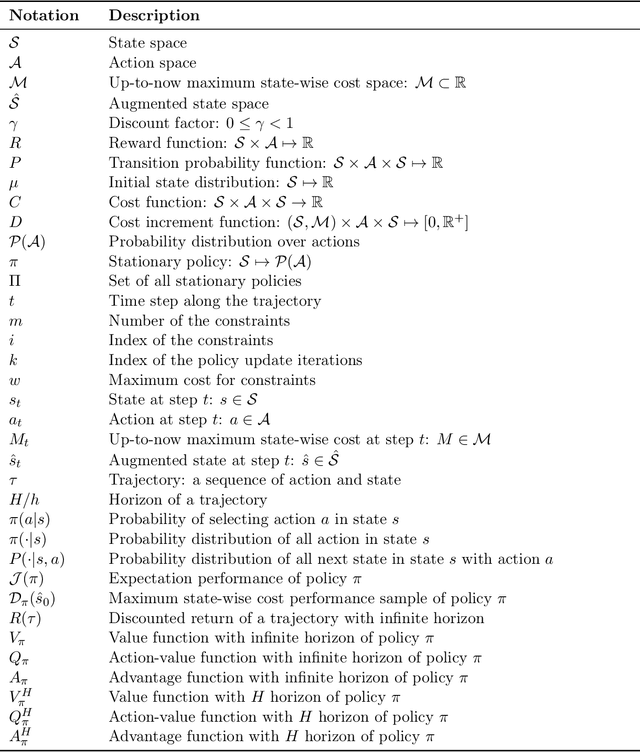

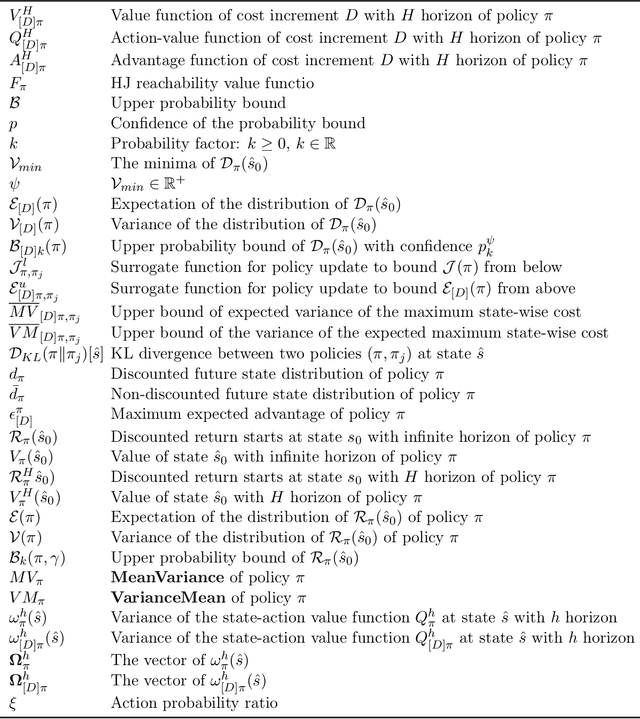
Abstract:Enforcing state-wise safety constraints is critical for the application of reinforcement learning (RL) in real-world problems, such as autonomous driving and robot manipulation. However, existing safe RL methods only enforce state-wise constraints in expectation or enforce hard state-wise constraints with strong assumptions. The former does not exclude the probability of safety violations, while the latter is impractical. Our insight is that although it is intractable to guarantee hard state-wise constraints in a model-free setting, we can enforce state-wise safety with high probability while excluding strong assumptions. To accomplish the goal, we propose Absolute State-wise Constrained Policy Optimization (ASCPO), a novel general-purpose policy search algorithm that guarantees high-probability state-wise constraint satisfaction for stochastic systems. We demonstrate the effectiveness of our approach by training neural network policies for extensive robot locomotion tasks, where the agent must adhere to various state-wise safety constraints. Our results show that ASCPO significantly outperforms existing methods in handling state-wise constraints across challenging continuous control tasks, highlighting its potential for real-world applications.
Efficient Multi-Task Large Model Training via Data Heterogeneity-aware Model Management
Sep 05, 2024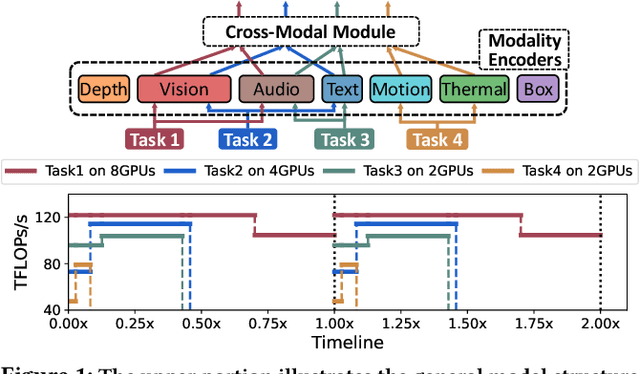
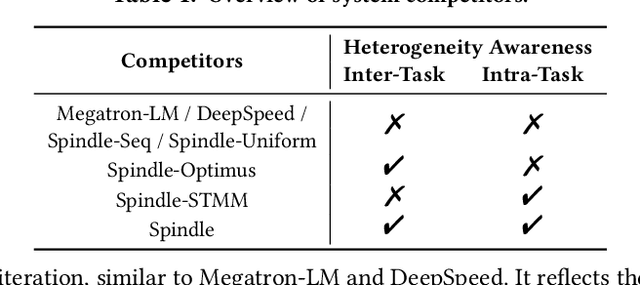
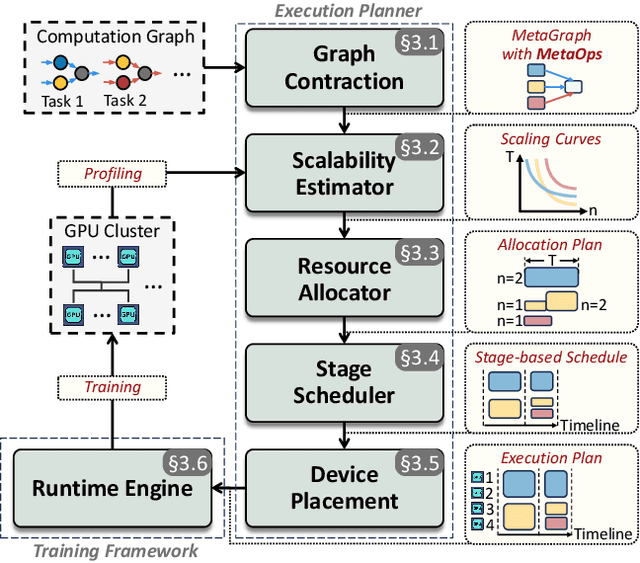
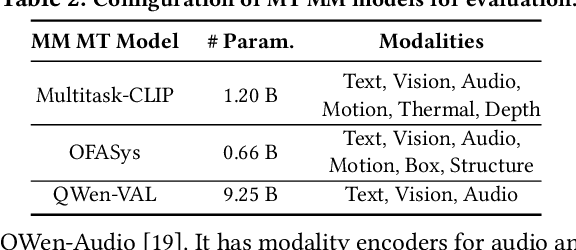
Abstract:Recent foundation models are capable of handling multiple machine learning (ML) tasks and multiple data modalities with the unified base model structure and several specialized model components. However, the development of such multi-task (MT) multi-modal (MM) models poses significant model management challenges to existing training systems. Due to the sophisticated model architecture and the heterogeneous workloads of different ML tasks and data modalities, training these models usually requires massive GPU resources and suffers from sub-optimal system efficiency. In this paper, we investigate how to achieve high-performance training of large-scale MT MM models through data heterogeneity-aware model management optimization. The key idea is to decompose the model execution into stages and address the joint optimization problem sequentially, including both heterogeneity-aware workload parallelization and dependency-driven execution scheduling. Based on this, we build a prototype system and evaluate it on various large MT MM models. Experiments demonstrate the superior performance and efficiency of our system, with speedup ratio up to 71% compared to state-of-the-art training systems.
First Activations Matter: Training-Free Methods for Dynamic Activation in Large Language Models
Aug 21, 2024Abstract:Dynamic activation (DA) techniques, such as DejaVu and MoEfication, have demonstrated their potential to significantly enhance the inference efficiency of large language models (LLMs). However, these techniques often rely on ReLU activation functions or require additional parameters and training to maintain performance. This paper introduces a training-free Threshold-based Dynamic Activation(TDA) method that leverage sequence information to exploit the inherent sparsity of models across various architectures. This method is designed to accelerate generation speed by 18-25\% without significantly compromising task performance, thereby addressing the limitations of existing DA techniques. Moreover, we delve into the root causes of LLM sparsity and theoretically analyze two of its critical features: history-related activation uncertainty and semantic-irrelevant activation inertia. Our comprehensive analyses not only provide a robust theoretical foundation for DA methods but also offer valuable insights to guide future research in optimizing LLMs for greater efficiency and effectiveness.
MOYU: A Theoretical Study on Massive Over-activation Yielded Uplifts in LLMs
Jun 18, 2024

Abstract:Massive Over-activation Yielded Uplifts(MOYU) is an inherent property of large language models, and dynamic activation(DA) based on the MOYU property is a clever yet under-explored strategy designed to accelerate inference in these models. Existing methods that utilize MOYU often face a significant 'Impossible Trinity': struggling to simultaneously maintain model performance, enhance inference speed, and extend applicability across various architectures. Due to the theoretical ambiguities surrounding MOYU, this paper elucidates the root cause of the MOYU property and outlines the mechanisms behind two primary limitations encountered by current DA methods: 1) history-related activation uncertainty, and 2) semantic-irrelevant activation inertia. Our analysis not only underscores the limitations of current dynamic activation strategies within large-scale LLaMA models but also proposes opportunities for refining the design of future sparsity schemes.
 Add to Chrome
Add to Chrome Add to Firefox
Add to Firefox Add to Edge
Add to Edge